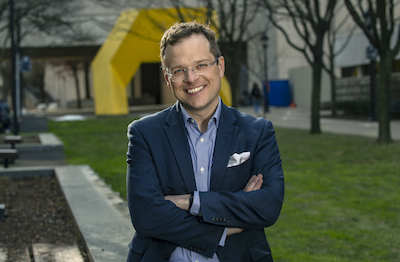The Pitt Green Spotlight is a monthly series highlighting people advancing sustainability, including Pitt Green Ambassadors and Pitt’s Green Offices & Labs!
We hope these spotlights will inspire you to try out new sustainable practices in your own campus experience! Want to be included in our next highlight? Contact us.
Pitt Green Spotlight:
Marc Coutanche, Associate Professor and Research Scientist, Learning Research and Development Center

Marc Coutanche is an Associate Professor and Research Scientist in the Language Research and Development Center (LRDC). He has led his own Green Lab at the Sapling level since 2023. He has helped other labs and offices in the LRDC to complete their own Green Lab and Green Office assessments to adopt greener practices, as well! Read on for more about Marc and how you, too, can help advance sustainability at Pitt.
Can you tell us more about yourself?
“I’m an Associate Professor of Psychology and a Research Scientist in the Learning Research and Development Center (LRDC). I grew up in the original (arguably superior?) Jersey – a very small island to the South of England. I left the island to get my Bachelor’s degree at Oxford University, followed by a few years working in London and Oxford. I came to the U.S. to get my Psychology PhD at the University of Pennsylvania. After a Postdoc at Yale, I came to Pitt in 2015. When I’m not teaching, my graduate students and I conduct Cognitive Neuroscience research into how the human brain supports cognition. My lab focuses on understanding long-term memory, perception, and the role of sleep in cognition, while developing new ways to analyze neuroimaging data.”
What got you interested in sustainability and acting on climate change?
“As a scientist, it’s difficult not to look at the data and conclude that we need to act. I first learned about climate challenges as a science-loving kid, and the evidence and urgency has only increased since. I take some solace from the last global response to another planetary crisis – a growing hole in the ozone layer. The world came together to phase out many ozone-depleting substances (like CFCs) from aerosols and other products in 1987. The hole has been shrinking ever since. It’s a fantastic example of scientific evidence motivating a policy change that then made a real difference. It also showed that limiting the use of particular chemicals is possible, and that it works.”
How would you recommend those just getting started with sustainability on campus get involved?
“Getting connected with Pitt Sustainability would be a great start because you’ll meet faculty, staff and students who care about the same issues. Also don’t be afraid to send out an email to people in your department, center, or program to create a climate-focused group. People often want to get involved but do not want to be the one to start. You can be that person! And even if just one person replies, that’s one more person to connect with than you had yesterday.”
What sustainability challenge would you like to tackle next, and what would you like to see the university address?
“If we are serious about reducing fossil fuel use, we need to provide attractive alternatives. Oakland is extremely difficult to navigate for pedestrians and cyclists alike. Construction projects are often necessary, but they don’t always necessitate closing off sidewalks and bike lanes for the whole project. The cumulative impact is that Oakland not pleasant to traverse, and it’s off-putting to the faculty, staff and students that we wish to recruit to our community. I’d also like to see enforcement of keeping the bike lanes clear. When you see a lot of cars idling or parked in a bike lane, it communicates that the bike lanes are merely suggestions. Plus, the resulting income could go towards sustainability efforts!”
Thanks to Marc for all your efforts to advance sustainability at Pitt!
